1 - Meeting the Mahatma
Published online by Cambridge University Press: 03 May 2011
Summary
The history begins with the man. ‘Gandhism’ was the child of the Mahatma, and at first was greatly overshadowed by its famed progenitor. Westerners were initially uncertain of the precise happenings in South Africa and India; the intricacies of ‘satyagraha’ they barely understood. Instead, it was the Mahatma's extraordinary being that itself compelled attention.
Americans and Brits were equally astonished by a rebel in dhoti and shawl; perplexed by his apparent undress; intrigued by his saintly vows and oracular speech. Gandhi not only led the Home Rule movement, he came to symbolise it, too. Westerners first met the Mahatma. His political methods were, at the beginning, a secondary concern.
In this chapter, I outline Western interpretations of Mohandas Gandhi from initial news reports to the height of his fame. The survey necessarily encompasses a changing context. Gandhi first gained Western attention in the aftermath of the great cataclysm of the First World War. He became a world figure as economic depression stalked the globe and Indians threatened the British Empire a decade later. And he was raised up as an immortal teacher in the years after his death, as the fear of atomic annihilation gave new resonance to a message of peace. Undoubtedly, these events shaped the Mahatma's discovery and appraisal. For now, however, I focus more closely on establishing the image of the Mahatma than on the background against which he stood out. The political context will be given greater attention in later chapters.
- Type
- Chapter
- Information
- Gandhi in the WestThe Mahatma and the Rise of Radical Protest, pp. 9 - 38Publisher: Cambridge University PressPrint publication year: 2011

